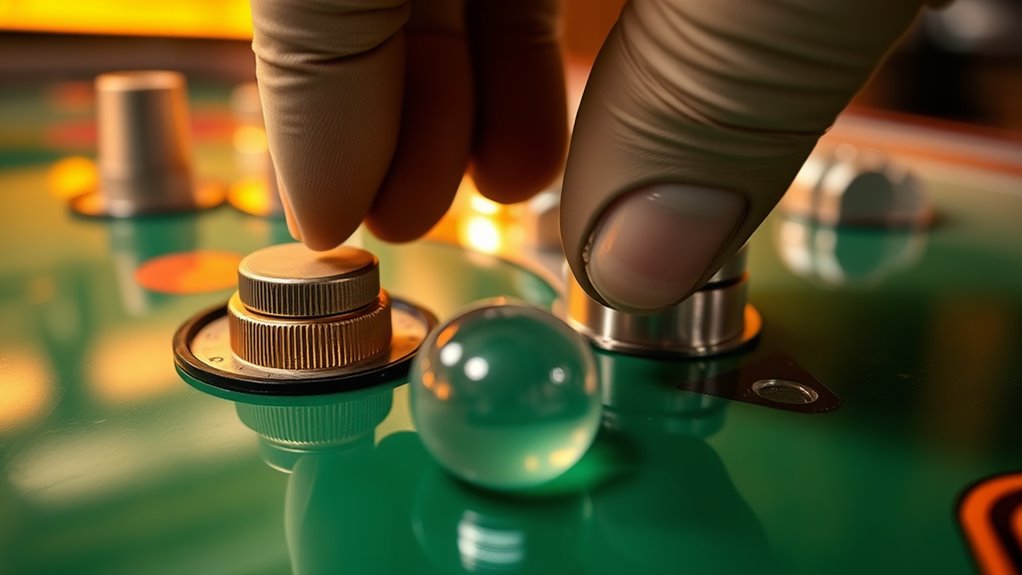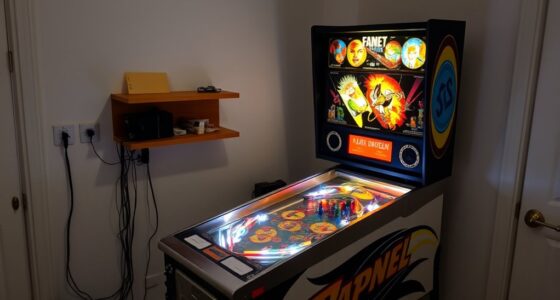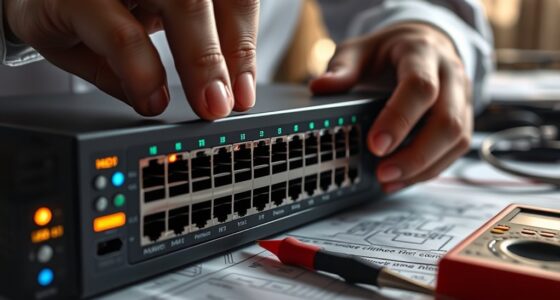To adjust your pinball tilt sensitivity, locate the tilt adjustment screws inside the backbox or cabinet and turn them slowly and incrementally while testing the machine after each change. To level the machine, use a spirit level or leveling tools on the playfield, adjusting the mounting legs as needed. Proper calibration is key to preventing false tilts and ensuring smooth gameplay. If you want detailed steps on achieving perfect tilt and leveling, keep exploring how to fine-tune your machine.
Key Takeaways
- Locate and turn the tilt adjustment screws inside the backbox or cabinet incrementally while testing the machine after each turn.
- Use a level tool to check the machine’s orientation and adjust the leveling feet to ensure a flat, even surface.
- Regularly verify tilt sensitivity settings and calibrate them to balance responsiveness with stability.
- Ensure coin lockout mechanisms and switches are clean and functioning to prevent false tilt signals.
- Inspect and replace worn flipper coils and check wiring to reduce electrical noise that may affect tilt sensor accuracy.

Have you ever wondered how to guarantee your pinball machine behaves just right during gameplay? Properly adjusting the tilt sensitivity and leveling your machine are essential steps to ensure a smooth experience. When your pinball game is too sensitive, even a slight jostle can cause unwarranted tilt warnings, disrupting the flow of play. Conversely, if it’s too insensitive, players might exploit the system or the game might not register legitimate tilts. Start by locating the tilt adjustment screws—usually found on the inside of the backbox or cabinet. Turn these screws slowly and incrementally, testing the machine after each adjustment to find the perfect balance. Remember, a well-leveled machine also plays a critical role; if it’s uneven, the ball might roll unpredictably, making gameplay frustrating or unmanageable.
Proper tilt adjustment and leveling ensure smooth, fair pinball gameplay every time.
While adjusting tilt sensitivity, it’s important to contemplate how coin lockouts impact gameplay. Coin lockouts control whether players can start a new game or add credits, and if they’re misaligned or malfunctioning, they can cause the machine to register false tilts. For example, a stuck coin lockout mechanism might jiggle during gameplay, triggering tilt sensors falsely. Ensure the coin lockout solenoids and switches are clean and functioning properly. Regular maintenance, such as cleaning contacts and lubricating moving parts, prevents these issues. If you notice coins jamming or the lockout solenoid sticking, address these problems promptly to avoid false tilt signals and ensure smooth coin operation.
Another common problem that can affect gameplay and tilt accuracy involves flipper coil issues. Flippers rely on coils to generate the force needed to hit the ball. If a coil is weak, damaged, or constantly overheating, it can cause inconsistent flipper response, making gameplay unpredictable. Sometimes, a malfunctioning flipper coil can generate vibrations or electrical noise that might falsely trigger the tilt sensor. To prevent this, check the flipper coil wiring for loose connections or shorts. If a coil shows signs of wear or damage, replace it with a proper coil designed for your machine. Properly functioning flippers not only improve gameplay but also help maintain the overall stability of the machine’s electronic sensors.
In short, adjusting tilt sensitivity and leveling your pinball machine involves a careful balance of mechanical and electrical considerations. Regularly inspect and maintain coin lockouts and flipper coils to prevent false signals and ensure a consistent gaming experience. When all these elements are properly calibrated and maintained, your pinball machine will behave just right, delivering smooth, fair, and exciting gameplay every time.
Frequently Asked Questions
How Often Should I Recalibrate My Pinball Machine’s Tilt Sensor?
You should recalibrate your pinball machine’s tilt sensor during your maintenance schedule, ideally every six months or after any significant movement or repair. Regular calibration guarantees accurate sensitivity and prevents false tilt warnings. Keep an eye on gameplay; if you notice unintended tilts or frequent false alarms, it’s time to check and adjust the calibration frequency. Consistent maintenance keeps your machine functioning smoothly and prolongs its lifespan.
Can Adjusting Tilt Sensitivity Affect Game Difficulty?
Think of tilt adjustments as tuning the balance of your game’s challenge. When you tweak the tilt sensitivity, you’re fundamentally setting the difficulty level—higher sensitivity makes it easier for the game to detect unwanted hits, increasing challenge. Lower sensitivity allows more aggressive play, easing difficulty. So, yes, adjusting tilt sensitivity directly impacts game difficulty, shaping your experience from a gentle stroll to a fierce test of skill.
What Tools Are Best for Leveling a Pinball Machine?
You should use a spirit level or a digital leveling tool to properly level your pinball machine. Start by applying leveling techniques such as placing the tool on the cabinet’s corners and adjusting the legs accordingly. Calibration tools like a bubble level or laser level help guarantee precision. Regularly check and fine-tune the machine’s level, which ensures ideal gameplay and prevents uneven wear on components.
Does Room Temperature Impact Tilt Sensor Accuracy?
Room temperature can impact sensor accuracy, including tilt sensors in your pinball machine. When temperatures fluctuate, materials expand or contract, which may cause slight changes in sensor calibration. Warmer temperatures might make sensors more sensitive, while cooler ones could reduce sensitivity. To guarantee ideal performance, keep your game in a stable environment, avoiding extreme temperature variations that could affect sensor accuracy and tilt response.
Are There Manual or Automatic Ways to Test Tilt Sensitivity?
You can test tilt sensitivity manually by gently tilting the pinball machine and observing if it triggers a tilt warning or reset. Many machines feature automatic adjustment options that calibrate tilt sensors during startup or through a specific menu. Regularly performing manual tests helps guarantee your tilt sensors respond accurately, while automatic adjustments can fine-tune sensitivity without much effort, keeping gameplay fair and enjoyable.
Conclusion
Now that you’ve fine-tuned your tilt sensitivity and leveling, your game is more balanced than ever. But remember, a tiny miscalibration can still send your ball spiraling out of control at just the wrong moment. Are you truly ready to master every bounce and tilt? Keep a close eye on your setup—your next game-winning shot might depend on it. The next challenge awaits, and only precision can keep you in control.









